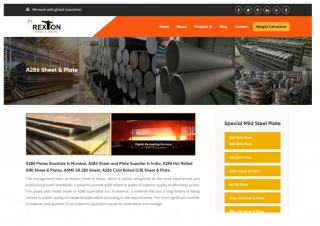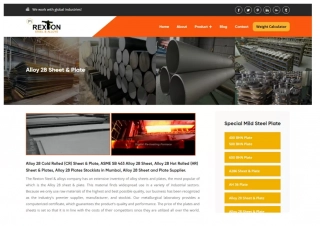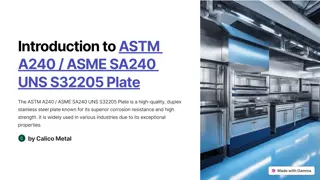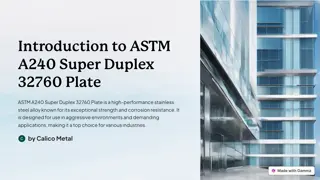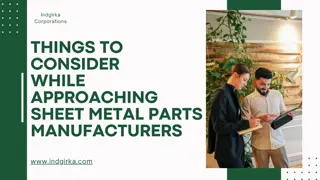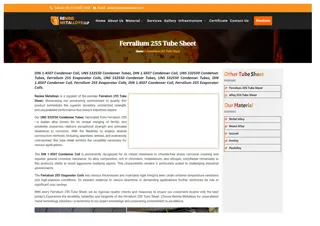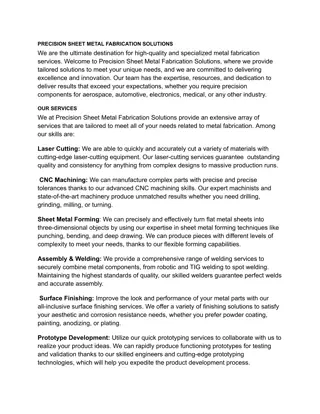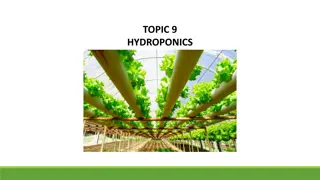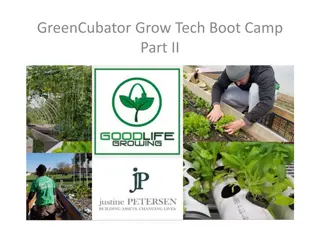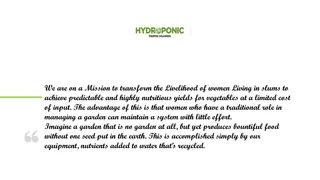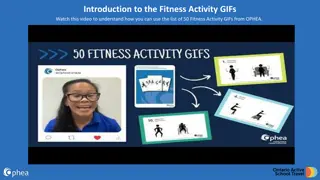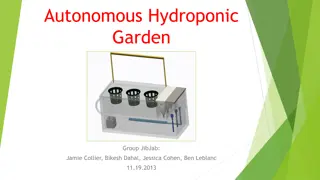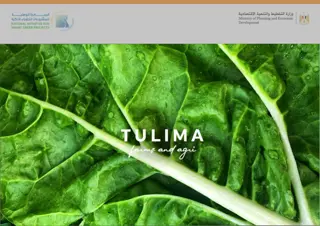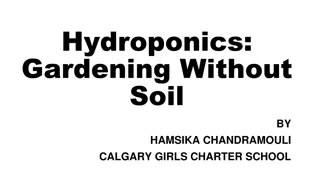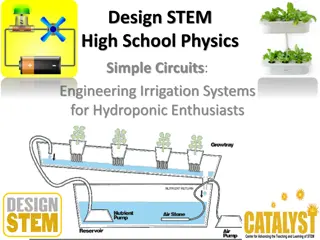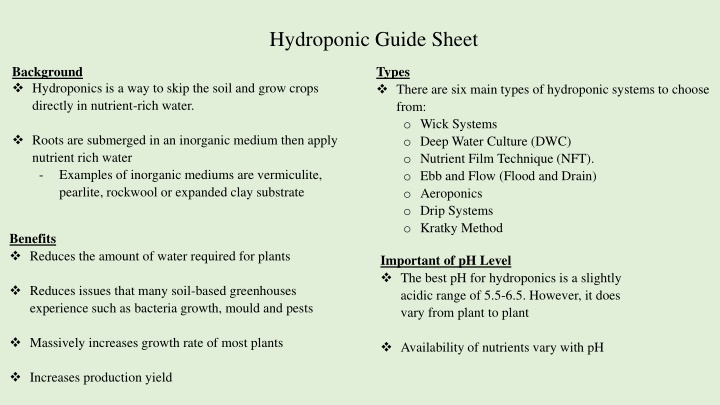
Explore Various Hydroponic Systems for Efficient Plant Growth
Discover the six main types of hydroponic systems - Wick, Deep Water Culture (DWC), Nutrient Film Technique (NFT), Ebb and Flow, Aeroponics, and Drip Systems. Learn about the benefits, pH levels, and optimal nutrient availability in hydroponics. Enhance your understanding of each system's background, pros, and cons to make an informed choice for successful crop cultivation.
Download Presentation

Please find below an Image/Link to download the presentation.
The content on the website is provided AS IS for your information and personal use only. It may not be sold, licensed, or shared on other websites without obtaining consent from the author. If you encounter any issues during the download, it is possible that the publisher has removed the file from their server.
You are allowed to download the files provided on this website for personal or commercial use, subject to the condition that they are used lawfully. All files are the property of their respective owners.
The content on the website is provided AS IS for your information and personal use only. It may not be sold, licensed, or shared on other websites without obtaining consent from the author.
E N D
Presentation Transcript
Hydroponic Guide Sheet Types There are six main types of hydroponic systems to choose from: o Wick Systems o Deep Water Culture (DWC) o Nutrient Film Technique (NFT). o Ebb and Flow (Flood and Drain) o Aeroponics o Drip Systems o Kratky Method Background Hydroponics is a way to skip the soil and grow crops directly in nutrient-rich water. Roots are submerged in an inorganic medium then apply nutrient rich water - Examples of inorganic mediums are vermiculite, pearlite, rockwool or expanded clay substrate Benefits Reduces the amount of water required for plants Important of pH Level The best pH for hydroponics is a slightly acidic range of 5.5-6.5. However, it does vary from plant to plant Reduces issues that many soil-based greenhouses experience such as bacteria growth, mould and pests Massively increases growth rate of most plants Availability of nutrients vary with pH Increases production yield
Wick System Background Also known as passive hydroponics Do not need air pump or water pump Nutrients and water are moved into a plant s root zone via a wick, which is often something as simple as a rope or piece of felt. Key to success in this system is the medium Pros o Good for smaller plants o Truly hands off if set it up correctly o Good for children and beginner Cons o Larger plants may have problem with getting enough nutrients and water o Incorrect wick placement or material can mean death for your plants Good choices include coconut coir, perlite, or vermiculite
Deep Water Culture (DWC) System Background Use reservoir to hold nutrient The roots of the plants are suspended in that solution, so they get a constant supply of water, oxygen, and nutrients. To oxygenate the water, use an air pump with an air stone to pump bubbles into the nutrient solution. This prevents roots from drowning in the water Pros o Very inexpensive and easy to make at home o Extremely low maintenance o Recirculating, so less wasted inputs Plants are typically housed in net pots that are placed in a foam board or into the top of the container Cons o Does not work well for large plants o Does not work well for plants with long growing period
Nutrient Film Technique (NFT) System Background Is a popular hydroponic system Plants are grown in channels that have a nutrient solution pumping through them and constantly running along the bottom of the channel. When the solution reaches the end of the channel, it drops back into a main reservoir and is sent back to the beginning of the system again. This makes it a recirculating system, just like deep water culture. Pros o Minimal growing medium needed o Recirculating system means less waste Unlike deep water culture, plants roots are not completely submerged Cons o Pump failure of any kind can completely ruin the crop o Roots can become overgrown and clog the channels Plants are placed in these channels using net pots and growing medium and can be replaced or harvested on a one-by-one basis. o Would required pre-germination of seeds
Ebb and Flow (Flood and Drain) System Background The tray is flooded with your nutrient solution a few times per day, depending on factors like: o The size of the plants o The water requirement of your plants o The air temperature o Where the plants are in their growth cycle Accomplished by using a reservoir below the tray, a water pump, and a timer to schedule the flooding cycle. Pros o Efficient use of water and energy o Highly customizable and flexible After the tray is flooded, gravity drains the solution back down into the reservoir, where it is being oxygenated by an air pump and air stone. It sits there waiting for the next flood cycle, and the process goes on. Cons o Roots can dry out quickly if environmental conditions are off or the pump or timer fails o Uses a lot of growing mediums
Aeroponics System Background Roots are mostly suspended in air Achieves this by misting the root zone with a nutrient solution constantly instead of running a thin film of nutrient solution along a channel Mist on a cycle like an ebb and flow system, but the cycle is much shorter, typically only waiting a few minutes between each misting. Pros o Roots often are exposed to more oxygen than submerged-root systems o High-pressure nozzles can fail and roots can dry out Also possible to mist on a continual basis and use a finer sprayer to ensure more oxygen gets to the root zone Cons o Not as cheap or easy to set up as other methods o Would required pre-germination of seeds
Drip System Background Extremely common in commercial operations, but less common in recreational gardens. Water is pumped in tubing that can end at a single plant or can branch off with several tubes ending at many plants Usually set on a timer Nutrient rich water flows over the grow medium and drips down over the plant roots Can be set up as either recover or a non drip recovery method Non recovery systems o Nutrient water that runs over the plant s roots does not go back into a reservoir o It s only used once Recovery systems o Reuse the nutrient solution after it is dripped over the roots o More efficient in saving money, water and nutrient solution Pros o High level of control over feeding and watering schedule o Less likely to break o Relatively cheap Cons o May be overkill for a smaller garden o Fluctuating pH and nutrient levels (if using recirculating system) o High waste (if using waste system)
Kratky Method Background Entirely passive No pumps required The nutrient solution remains stagnant Pros o No electricity needed o Minimal maintenance o Minimal cost As the plants drink from their small reservoir and the water level drops, an air gap grows between the nutrient solution and the plant itself, allowing the plant to breathe without oxygenating the reservoir. Cons o Harder to control when the system is outdoor due to rain water may flood the system and dilute nutrient solution o Larger plant grows slower o May have pests problem due to stagnant water o Need quality water to start (be aware of the salt and the pH) o Harder to control temperature When more water is added into the reservoir, it is important to leave an unfilled area open for the roots to breathe Works better indoor or in a greenhouse or covered area


